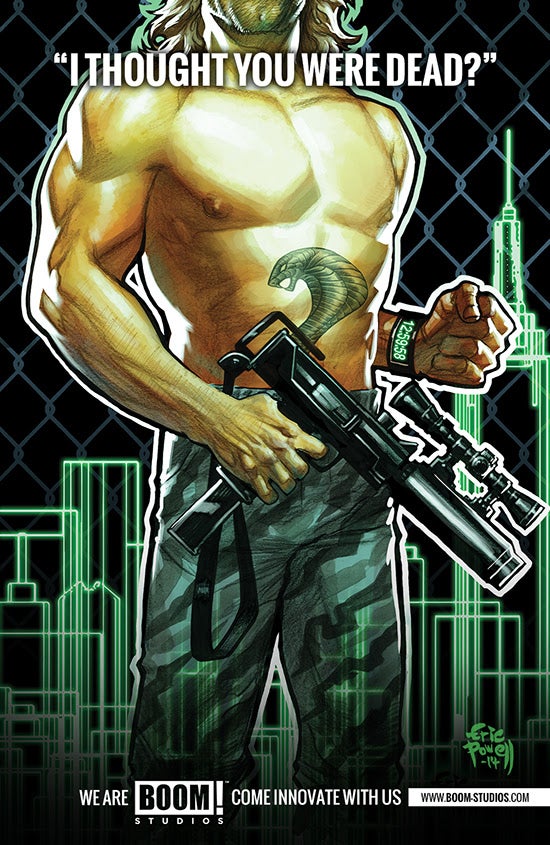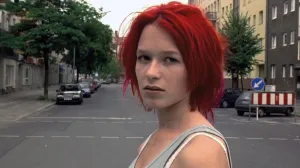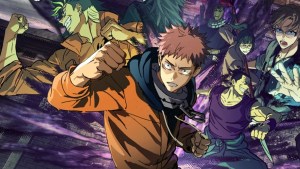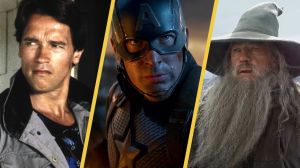
Videos by ComicBook.com
The series, which picks up immediately following the events of the film by the same name, will allow the Dead Letters and High Crimes writer to explore the world of the Escape From… films beyond the walled-off streets of New York and Los Angeles (and will do so in the time between the two films, so Escape From L.A. won’t play into the plot at all).
The book is a dream gig for Sebela, who reportedly put out feelers after the Big Trouble in Little China comic was announced and then accepted Escape From New York with no information beyond the fact that it was an Escape From New York comic.
So, how did that work out for him? The writer joined ComicBook.com to talk about his series, which debuts December 3 from BOOM!.

Carpenter isn’t as involved in Escape as closely as he is with Big Trouble, where he and Eric Powell worked on story stuff together.
So far he’s been happy with what we’re doing and has made some suggestions. I’d love it if he joined up and we became best friends, but I’m taking this book one dream scenario at a time. Having him on board is good for now, we can work on the rest as we go.
You’ve said that the story picks up at the end of Escape From New York and the LA isn’t a consideration for you. There have been some Plissken comics over the years; did you re-read any of those, to see where they went right and wrong?
I know about those books, and my editors are familiar enough with them to make sure there’s no inadvertent overlap, but I haven’t read them. Mostly to keep myself “pure,” I guess. I’m afraid of ideas seeping in while I’m not looking. I really just wanted to take a running leap at it without worrying about what other people have done. Most of my research was rewatching Escape From New York a lot.
Obviously there have been various attempts to make a sequel or reboot happen over the years on film. What do you think it is about this film that is both so enduring that people want it and so difficult to adapt that they keep stalling out?
I think the only reason the sequels have been stalled out is studios refuse to give Carpenter all the money. He did have a third Snake Plissken movie in mind, Escape From Earth, but the budget that would require is prohibitively high, I’m guessing. And they keep talking about the inevitable reboot for several years, but nothing has come of it so far, thankfully. I’m of the opinion that Escape From New York is very much of its time and very much great as it is, and it should be left alone.
As for its endurance, those things are different for everyone. I will say that since it’s maybe the first movie to decapitate the Statue of Liberty — even if it was only on the poster — that carries a lot of mileage on its own. Otherwise, it’s a dark, cynical movie, but it has a sense of humor, it draws on Carpenter’s twin pedigrees of horror and action and smashes them together perfectly. And Snake, Snake is just one of those characters you don’t see coming and when you lay eyes on them, it’s like you’ve been sitting around waiting for him to show up.
Movies are a weird alchemy, it’s hard to make them come together in a perfect way and it’s even harder to point out why it works, but Escape From New York, even as our CGI budgets balloon and our concepts get even higher-concept, still feels relevant and timeless to me.
It seems like we’re in a bit of a golden age for licensed comics, no? For a long time, seeing something imported from other media generally indicated it was going to be a trainwreck, but now some of the most consistently entertaining mainstream books are adaptations. What do you think changed?
I can’t speak for anyone else, but BOOM! treats licensed books the same way they do creator-owned books. They pick creators they feel are right for the project and they let them go off and come up with big crazy stories, there’s a huge allowance for you to try out stuff, even if it doesn’t work. It also helps that we’re all fans of the source material. Diego Barreto and Marissa Louise, the artist and colorist, are big fans and it shows in their work. My editors, Ian Brill and Alex Galer, are equally big fans of the film, and sometimes our email chains spin off into us geeking out about the movie or the book. They’re also my voice of reason when I get some ridiculous idea at three in the morning and email it to them. The studio has been really receptive to the ideas and they’re not actively pursuing a sequel, so the horizon is wide open for us to do ideas that both make sense to us and really up the ante.
But ultimately, when I sit down to work on it, Escape From New York has the same feel of when I’m breaking one of my own ideas, which keeps me really excited about it and, I think, reflects in the final work.
I’d say you’re best known for indie work, but obviously right now you’re doing Alien and Escape From New York, and have recently had stories in Fantastic Four and Shadowman. Are you steeling yourself for dealing with the hardcore fans online?
Doing something like this, you know that you can’t please everyone. Especially with a film as iconic as Escape from New York. It’s had 30+ years of people watching and rewatching it and making their own narratives, their own ideas of what is proper Snake. But I know that I’ve been a diehard fan of the film since I was a kid and I’m trying to write the book I want to read as a fan of Carpenter, Plissken and the film. It’s impossible to match everyone’s vision of what should come next, but I think that’s a good thing, and I think die-hard fans of all things Snake as well as just casual enjoyers of the film will be pleased with where we take it.
The cast of characters in Escape… were great, but they’re pretty much all dead at the end of the movie. Will you be treating Snake more like a lone wolf character or will you be rebuilding the cast and trying to recapture some of that aspect of the film?
A little of both? Snake is a lone wolf in that movie, but he finds himself running into people, trapped with them, and allowing them into his life a little bit. The original opening of the film was Snake robbing the federal depository with a friend and his friend getting gunned down. It’s a scene worth watching because it’s Snake being momentarily human, dropping his guard just a second. I like that Snake just wants to be alone, to be the lone wolf, but he’s human like the rest of us, and even if he wouldn’t admit it, a little company is good to have. Snake’s problem is whenever he lets the mask slip, the people he lets in get killed, as far back as when he was fighting in Siberia and Leningrad.
Ultimately, it’d be a pretty boring book if it was just Snake on his own. Snake works best when he’s got something to react to, to draw him out, so the cast will be constantly growing and shrinking as we go. Don’t expect him to join a team of outlaws or get engaged. But if we’re doing a look at what America is like in this alternate dystopia, you need other people to reflect that best, even if they only show up to get their heads blown off.
Are there any likeness rights issues here? I mean, I assume Snake is taken care of, but will your artists have to reenvision Hauk or anyone?
Yeah, we have Kurt Russell’s likeness locked in, but everyone else is more complicated, so we’ve figured some ways to dance around this. It was a challenge at first, but it definitely pushed me to up my game and really go for it with every scene, every issue and every arc. I think people will dig the little magic act we pull off.
I can’t help but think from a description you gave of someplace that’s totally bats–t insane in a previous interview that your first arc will be taking place in Florida. How much fun is it to explore some of the world outside of the prisons we’ve seen?
It’s great. It was my immediate first thought when I cracked my notebook and started figuring out the book, was that we’ve already seen New York, we know what it is. It’s kind of the baseline. And if your baseline is America giving up and turning NYC into a walled maximum security prison for the entire country, then the rest of the country is an endless possibility, there’s so many things that could be roaming that 1997 America. So I kind of wanted to do it as a travelogue. The first arc is very much about establishing that feel, of a man on the run, who has escaped from the height of insanity and finds that he’s climbing uphill now, to even stranger vistas. And when you think America and Weird, or at least when I do, you think Florida. It felt very natural to me.
Obviously, post-apocalyptic futures are a dime a dozen. What did you do to keep the feel of this one intact as much as possible, especially while losing most of the cast and leaving behind the setting?
It’s all about tone. Both of the Escape films have that same sardonic, shrugging-with-a-knife-in-your-back feel to them, of a world full of insane possibilities and in the eye of that storm is Snake, the most sane person we can hold on to. Snake doesn’t give a lot up about who he is or how he feels, he’s learned to stuff that away, so he can act as a cipher, a man incapable of being phased thrown into the most double-take situations ever without ever blinking. So it’s about taking that template, of Snake, of Dean Cundey’s cinematography, of Carpenter and Nick Castle’s script, and holding onto that as my compass, but not feeling like I had to limit myself. Doing this as a book means we can really open it up, we can go all sorts of directions, but we’ll never be throwing ourself out of a plan without a chute, we always have the stuff that made the original film so lasting as our guide.
This seems like it could be challenging as hell, in terms of capturing the feel of this world and the likenesses without feeling derivative. Are you giving your artists any special direction in that regard?
In comics, it’s very much about trusting your collaborator. And when I started getting pages in from Diego, I knew we were on the same page, tonally, and I didn’t have to worry about anything. It’s helpful to let go, to not micromanage, so I make sure to say everything I want to say in my scripts and let him go to town without getting in his way. I will send him reference images, trying to ground this book in as much reality as we possibly can with settings and set pieces, but he’s been knocking it out of the park so far. It’s a challenge for sure, but I feel like Diego’s really capturing a lot about the look and feel of the original movie’s sets and cinematography that helps make it all feel like a natural continuation of what the first film established so perfectly.








